A fellow trekker asked me what the highlight of my Fairbanks orientation has been. Even with a mental haze induced by an intense week of 12 to 14 hour work days and a late 1:00 am flight home, my answer was definitive and quick - the field trip to the PERMAFROST TUNNEL!
A Discovery!
Dr. Patrick Druckenmiller, from the University of Fairbanks Alaska, led us down the PermafrostPermanently frozen ground. Tunnel Research Facility, located just outside of Fairbanks.
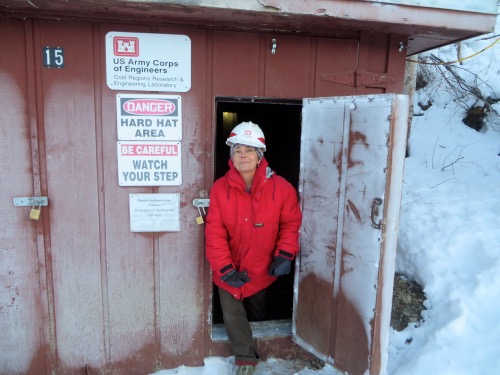
Even protected by the outside winds, the interior of the tunnel was cold. The wall temperature read -4 C. I think the air temp. was even colder. My toes had a cold work out.
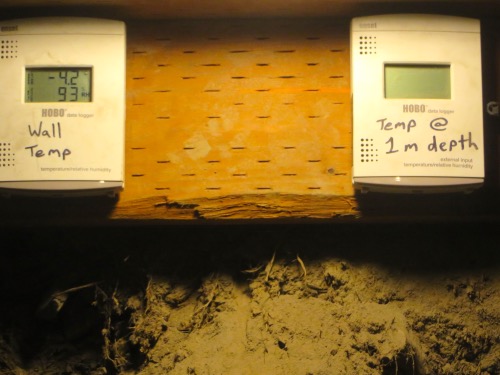
Dr. Druckenmiller showed us a 14,000 year old bison bone sticking out of the wall. Other ice-age mammals of the Alaskan tundra typically found in the loess and gravel mix here in the PermafrostPermanently frozen ground. Tunnel include mammoth and horse. But no carnivores until today.....
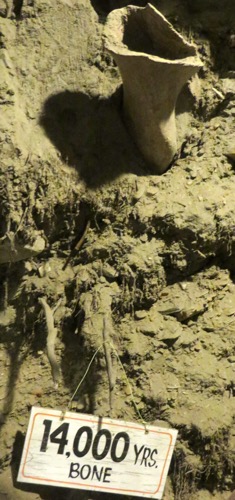
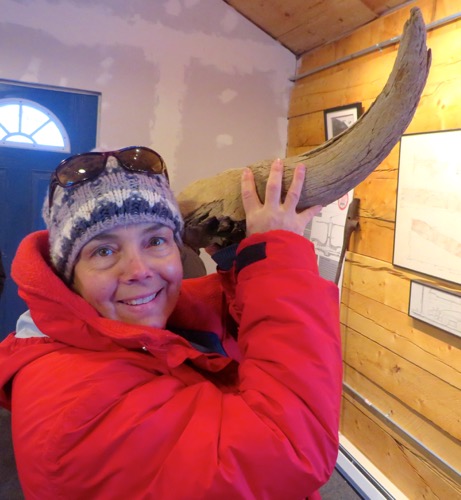
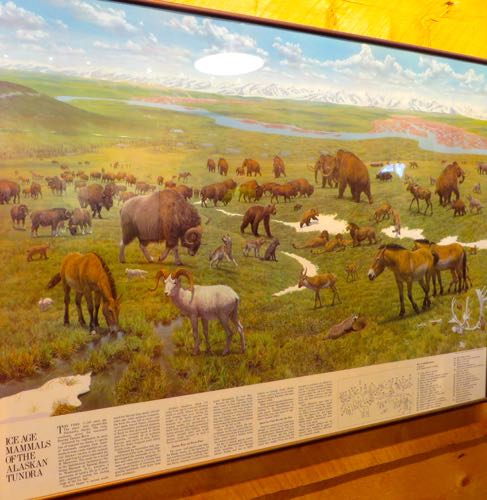
A few steps into the tour, Dr. Druckenmiller suddenly stopped and noticed a new fragment of bone propped conveniently on a small shelf of the excavated tunnel. He picked up the fossil, blew off the silty loess and remarked with cautious surprise, "Hmmm...a small carnivore bone. This a first. We have not found a carnivore fossil, ever, in this tunnel." He showed us the bone and how another carnivore had left bite marks in the bone. He quietly pocketed the bone fragment and mentioned that he had the authority to "collect" and would take it back to the lab to confirm his discovery!
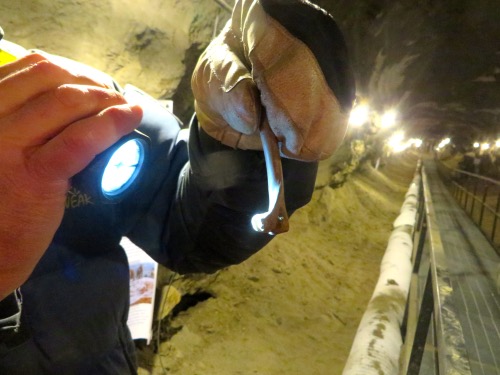
Other fascinating attributes of the tunnel include...
ice wedges
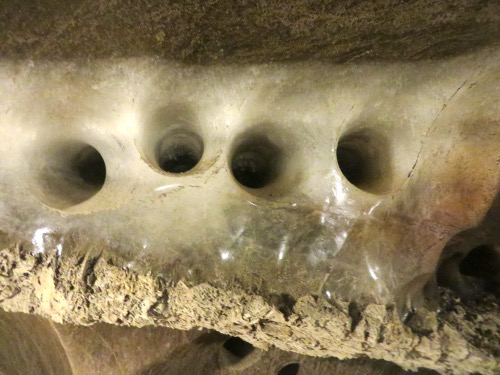
reticulate-chaotic ice
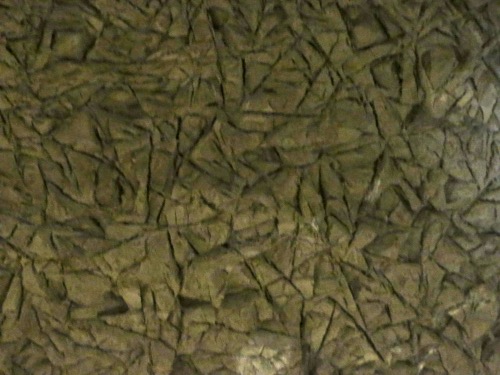
...and the remains of roots and other organic material still un-decomposed after 40,000 years. Some fragments have remnants of chlorophyll - the pigment responsible for photosynthesis in plants - a very delicate molecule - which degrades quickly under natural atmospheric conditions.
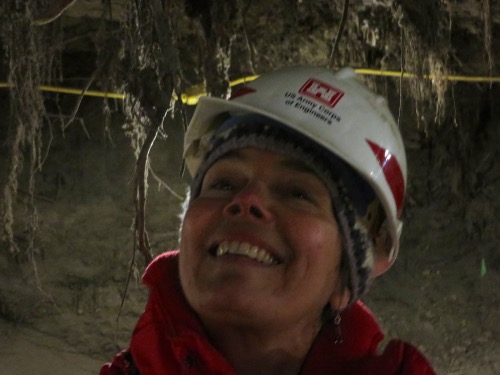
But Weirder Still...
Dr. Druckenmiller pointed out a fungus, capable of living and reproducing at temperatures below zero. This reminds me of the hibernating ground squirrel I learned about earlier in the week. In fact - the fungus and the squirrel have something in common. Their cells have the ability not to burst open when the temperature drops below the freezing point.
Fungus with this ability are called psychrophiles or cryophiles. According to Wikipedia, these organisms can live within a range of -20 C to + 10 C. Their cell membranes have a lipid that is resistant to the stiffening caused by extreme cold and their cells can also produce a protein that acts like anti-freeze.
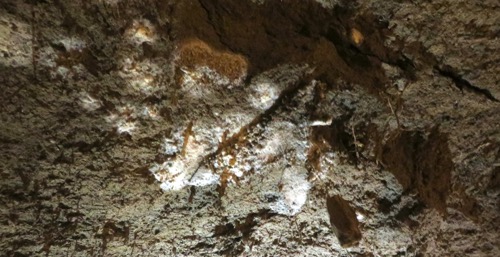
The Boy and His Dinosaur Bone
But the true highlight came from the seven year old boy who joined us on the tour.
[img12] boy
This boy was bursting at the seams with questions throughout the tour, and even put the eight teachers to shame by answering one of Dr. Druckenmiller's questions with more understanding than us. At the end of tour, we stepped inside to warm up and re-cap what we had learned.
The boy pulled out of his plastic bag, bones he had been hauling around with him, bones that his dad had found while doing construction in the area. Dr. Druckenmiller looked closely, put the bone up to his nose and sniffed. He said, yes indeed, this bone was 69 million years old. We all laughed, thinking he was just pulling the boy's leg. But no, in fact, Patrick continued in his rather unassuming manner, that this was in fact a dinosaur bone, one he was very familiar with. In fact, Dr. Druckenmiller had actually named this particular creature! How serendipitous is that? It almost felt staged it was so surreal. Without knowing it perhaps, Dr. Druckenmiller may have just created the next generation of Paleontologist in this 7 year old boy. The PolarTREC teachers walked away with glee, telling and re-telling the story of "The Boy and His Dinosaur Bone".
A New Species
Dr. Druckenmiller named the dinosaur, "Ugrunaaluk kuukpikensis, which means "ancient grazer of the Colville River. The animal was nearly 30 feet long and lived 69 million years ago in the Upper Cretaceous."
Learn More[Duck Billed Dinosaur]http://www.sci-news.com/paleontology/science-ugrunaaluk-kuukpikensis-duck-billed-dinosaur-03259.html
Glossary
permafrost "permafrost or cryotic soil is soil at or below the freezing point of water 0 °C (32 °F) for two or more years. Most permafrost is located in high latitudes (in and around the Arctic and Antarctic regions), but alpine permafrost may exist at high altitudes in much lower latitudes." https://en.wikipedia.org/wiki/PermafrostPermanently frozen ground.
paleontology "the science that deals with the fossils of animals and plants that lived very long ago especially in the time of dinosaurs." http://www.merriam-webster.com/dictionary/paleontology
paleoclimatology "is the study of changes in climate taken on the scale of the entire history of Earth. It uses a variety of proxy methods from the Earth and life sciences to obtain data previously preserved within things such as rocks, sediments, ice sheets, tree rings, corals, shells and microfossils. It then uses the records to determine the past states of the Earth's various climate regions and its atmospheric system. Studies of past changes in the environment and biodiversity often reflect on the current situation, specifically the impact of climate on mass extinctions and biotic recovery." https://en.wikipedia.org/wiki/PaleoclimatologyThe study of the Earth’s past climates.
paleogeology "a branch of geology concerned with the study of geologic features exposed at the surface during a past epoch or period but now buried beneath rocks formed in subsequent time."http://www.merriam-webster.com/dictionary/paleogeology
loess "an unstratified usually buff to yellowish brown loamy deposit found in North America, Europe, and Asia and believed to be chiefly deposited by the wind" http://www.merriam-webster.com/dictionary/loess
ice wedge "a crack in the ground formed by a narrow or thin piece of ice that measures up to 3–4 meters in length at ground level and extends downwards into the ground up to several meters. During the winter months, the water in the ground freezes and expands." https://en.wikipedia.org/wiki/Ice_wedge
reticulated chaotic ice "The ice lenses form in a randomly-oriented, multi-directional pattern. This ice pattern is seen around thermokarst-cave ice. The pattern forms from enclosed areas of thawed permafrost, where the soil is in a closed-system and freezes inward from many directions instead of only in the downward direction. In the photos, the ice is dark brown to black in color." http://permafrosttunnel.crrel.usace.army.mil/permafrost/cryostructures.html


Comments